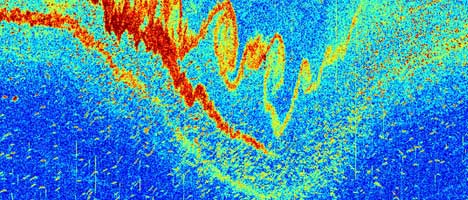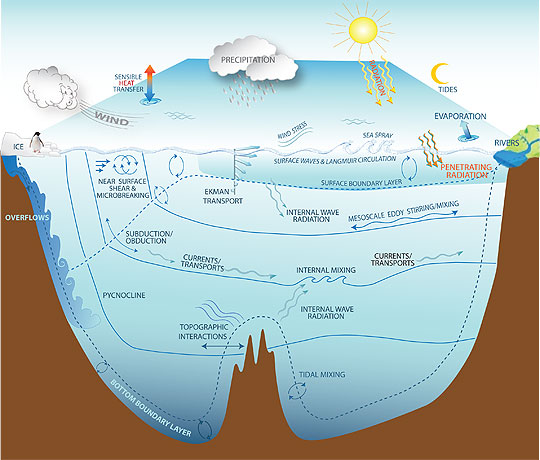Ocean Mixing
Small-scale mixing processes are an important component of the large-scale ocean climate, providing cross-isopycnal fluxes of heat, salt and other tracers. (see figure 1) Examples include wind- and buoyancy-driven mixing in the ocean surface layer, instabilities driven by large-scale shear and internal waves in the ocean interior, double-diffusive interleaving, and frictionally-driven processes at the bottom boundary. These processes occur on scales much smaller than the climate model grid-scale, and so must be parameterized (represented in terms of resolved scales) in climate simulations.
Large-scale ocean climate, including the meridional overturning circulation, the uptake of anthropogenic carbon dioxide by the ocean, the heat uptake by the ocean, and global biogeochemical cycling, can be impacted by the small-scale fluxes due to these mixing processes. Our goal is to develop efficient physically-based parameterizations of these processes, using a combination of high resolution simulations which resolve the predominant scales of the mixing, and information from laboratory experiments, theory and ocean observations.
GFDL Research
Mixing in Overflows
Oceanic overflows are bottom-trapped dense gravity currents originating in semi-enclosed basins, such as the Nordic seas, or on continental shelves, such as the Antarctic shelf, and are the source of most of the abyssal waters. As they descend the continental slope, overflows mix vigorously with the surrounding oceanic waters, changing their density and transport significantly. These mixing processes occur on spatial scales well below the resolution of ocean climate models, and must therefore be parameterized (Legg et al, 2009). GFDL research has focused on the development of improved parameterizations of the shear-driven mixing between the overflow and overlying water (Jackson et al, 2008; Ilicak et al, 2011) and mixing in the frictional boundary layer (Legg et al, 2006), better representation of the flow through narrow gaps (Adcroft, 2013), novel representation using an embedded Lagrangian sub-model (Bates et al, 2012a,b) and understanding the impact of overflow representation on the large scale circulation (Zhang et al, 2011; Wang et al, 2014).
Internal-wave-driven mixing
The energy required for mixing in the stratified ocean interior is largely supplied by the tides and the winds, which excite internal waves (waves where the stable density stratification of the ocean provides the restoring force), which then cascade energy to small scales, leading to turbulent mixing. GFDL researchers are examining the local breaking of tidally-generated internal waves at tall steep topography (Legg and Klymak, 2008; Klymak et al, 2010) and through nonlinear wave-wave interactions (Nikurashin and Legg, 2011), and the remote breaking of low-mode waves at large amplitude topography (Legg, 2014). Internal waves are also generated by geostrophic flows over topography (Nikurashin et al, 2013).
As part of the multi-institutional Internal-Wave Driven Mixing Climate Process Team, energetically-consistent parameterizations of these processes are being implemented in GFDL ocean climate models, demonstrating sensitivity to the magnitude and horizontal and vertical distribution of internal-wave driven mixing (Melet et al, 2013; Melet et al, 2014).
Surface mixed-layer
GFDL work on surface mixed layer processes includes the impact of submesoscale eddies on mixed layer restratification (Fox-Kemper et al, 2008, 2011), the parameterization of heterogeneous ocean convection (Ilicak et al, 2014), and energetically consistent representations of the boundary layer dynamics (Hallberg, 2003).
Reducing spurious mixing
Studies of the impact of energetically-consistent mixing parameterizations on the simulated climate are not possible if the ocean model formulation leads to poorly constrained spurious numerical mixing (Griffies et al 2000; Ilicak et al, 2012). An important GFDL effort has therefore been the development of numerical methods for ocean models designed to minimize spurious mixing (White et al, 2009; White and Adcroft 2008; Adcroft and Hallberg, 2006).
Together with partners at National Center for Atmospheric Research and Los Alamos National Laboratory, GFDL is developing CVMIx, a community software package which includes the vertical mixing parameterizations described here, as well as others used by the ocean climate modeling community (e.g Large et al, 1994).





